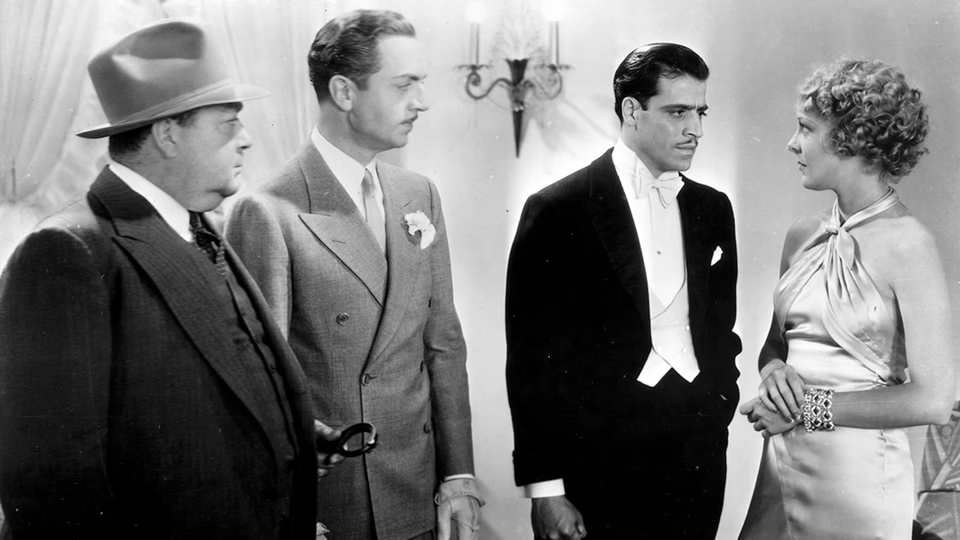The Kennel Murder Case

After three years, William Powell returns as amateur detective Philo Vance for the fourth and final time. This installment sees him investigate a ruthless businessman’s apparent suicide.
Despite the title, a kennel does not factor into the mystery. Rather, the film opens at the Long Island Kennel Club dog show, where Vance has entered his beloved terrier. Also competing is Archer Coe. Archer’s chief competition is Sir Thomas, who is involved with Archer’s niece Hilda, played by Mary Astor. Hilda bemoans to Sir Thomas that her uncle is a horrible, ruthless man and she hopes Sir Thomas’s dog wins.
Later that night, Sir Thomas discovers his dog dead. Meanwhile, Archer storms out of his lover Doris’s apartment and cancels a deal to sell a Chinese antiquity collection because she’s having an affair with the buyer. This threatens to ruin the buyer, an Italian named Grassi.
The next morning, Archer’s butler finds him dead, locked in his bedroom, a gun in his hand and a bullet hole in his temple.
Vance hears the news as he’s about to sail to Italy, but cancels his trip to investigate. He rides to the crime scene with District Attorney Markham, now played by Robert McWade. Upon arriving, the film offers a welcome nod to series fans with Eugene Pallette—returning as Detective Heath—greeting Vance on arrival and saying with a grin, “Well, it’s been a long time.”
“Several years,” replies Powell, referring to his last appearance in The Benson Murder Case.
As Vance investigates, even more suspects emerge. Archer’s secretary Wrede wanted to marry Hilda, but Archer laughed at him. Archer’s cook, a Chinese immigrant, aided Archer—sometimes through illegal means-in amassing his collection of Chinese antiques and opposed the sale. Even Archer’s own brother, Brisbane, hated him. Topping it off, the butler, Gamble, hides a criminal past.
Director Michael Curtiz delivers some formal flourishes absent in the series’s earlier installments. He depicts an early phone call between Vance and Markham via split screen, and later proffers an ambitious tracking shot that starts with Powell in one building, pans out the window, arcs across the cityscape, and focuses on a room across the street.
But the final film hints at a rushed production. During the aforementioned tracking shot, the seam between the shot’s miniatures and live action proves glaring. And earlier, during a panning shot across a room, a lamp obscures the action.
No wonder. Cramming all these plot threads into the brisk seventy-three-minute running time leaves little room for mistakes. It also doesn’t leave much room for Powell, who proves less a personality than a plot device to discover clues and proffer exposition. This rest of the cast suffer a similar fate, their characterization limited to their motives for murder.
But perhaps worst of all, the mystery underwhelms. The contrived solution requires Powell to use an elaborate scale model to convey the logistics. This plays like a filmed lecture. Fortunately, Curtiz cuts to a flashback from the killer’s point of view. Powell narrates the action. But even this proves clumsy, as Curtiz must cut between the killer’s POV and a third-person perspective.
Better to have leveraged the split-screen technique from earlier. Imagine two continuous shots. One from the killer’s POV as he first attacks. Then, believing the job done, retreats across the street. On the split screen, an unbroken third-person shot could follow Archer as he recovers from the initial assault and retires to his bedroom, where the shots would link in dramatic fashion as the killer spies Archer alive. Then they split again, as we follow the killer’s return journey, while the third-person side chronicles Archer’s fate before the shots link again on Brisbane.
Granted, such a technical challenge would have eclipsed the film’s budget and shooting schedule, but it would have made the convoluted plotting worthwhile, and rendered this a classic. As is, the proffered explanation falls apart at the slightest introspection and hinges on the killer giving himself away after the fact. Disappointing. When all you’ve got is plot, it better pay off.